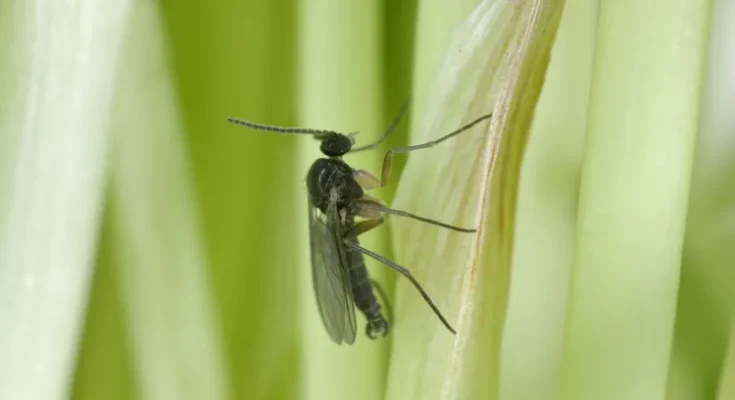Fungus gnats are a common pest among houseplants. These small flies tend to go unnoticed at first, slowly building their populations by laying eggs on the soil of our container plants. Their larvae feed on fungi and organic matter in our potting soil and nibble on plant roots as well. As much as we’d like, they don’t go away on their own. Over time, their numbers grow, and you begin to notice the adults hovering above the soil surface when you water your houseplants.
Fortunately, fungus gnats are more of a nuisance than anything. And they are easy to control. Learn how to get rid of fungus gnats and apply these strategies to avoid having problems with them in the future.
What Are Fungus Gnats?
Fungus gnats are small flies that infest soil, potting mixes, and other media. The adults look a bit like mosquitoes, though plumper, with antennae that are longer than their heads. They grow to 1/16- to 1/8-inch long and have light gray to clear wings. Adult fungus gnats are short-lived and do not feed on plants or harm people, but you are likely to see them flying around houseplants looking for a place to lay eggs. The adult flies are also attracted to light, so you might first notice them flying near a window.
The larvae of fungus gnats live in the soil where they feed on fungi and organic matter, but they also eat plant roots. The larvae are thin maggots, with a shiny black head and long, whitish-to-clear, legless body. When present in large numbers, they can damage roots and stunt plant growth. This type of damage is rare in the home setting. Feeding damage often presents as wilting, which can be hard to differentiate from other plant stresses.
What Causes Fungus Gnats?
Fungus gnats are ubiquitous, and often enter the home on new houseplants. They are present outdoors, but do not cause problems in the garden setting. However, they are commonly brought indoors on plants that have been outdoors for the summer and are brought back in for winter. As such, these pests are most noticed during the fall and winter. Fungus gnats tend to be the greatest problem in plants that are overwatered, which encourages growth of soil fungi, the gnats’ primary food. Managing soil moisture is among the primary methods to control and avoid problems with fungus gnats.
How To Discourage Fungus Gnats
The most effective control methods target the larval stage. The single most important step in managing fungus gnats is altering the environment within houseplant containers. Adult fungus gnats lay their eggs on moist soil. You can eliminate favorable egg-laying sites by allowing the top inch of potting soil to dry out before you water. Bottom watering also works well, providing ample moisture to roots while minimizing surface moisture. Covering the soil with a ½ inch of coarse sand or fine gravel can also discourage egg laying.
When To Use Insecticides
Insecticides are only a temporary measure and generally not recommended for home use. Pyrethrin insecticides, which are derived from chrysanthemum flowers, are fast-acting if you have an overwhelming population of fungus gnats flying around. However, it’s safest to move your plants outdoors before spraying the foliage and soil.1
For large infestations, use a biological control agent instead. The bacterium Bacillus thuringiensis subspecies israelensis, commonly called Bti, targets larvae of flies. You can find Bti products such as Mosquito Bits and Gnatrol at nurseries and garden centers. It is important to note that Bti products labeled for controlling caterpillars are not effective against fungus gnats, as they belong to a different strain of the bacterium.
To apply, mix the Bti with water and then drench the soil. Though derived from a bacterium, Bti is not a living organism and does not persist indoors. As such, you may need to make multiple applications five to seven days apart to control newly hatched fungus gnat larvae. Always follow label directions for application rates and frequencies.
How To Use Traps
Fungus gnats can also be managed to some extent through trapping. Yellow sticky cards, available at nurseries and garden centers, are used to monitor pests by trapping adults. As such, they also reduce fly populations. Note that vinegar-based traps commonly used for fruit flies do not work for fungus gnats. Larvae of fungus gnats can be trapped using chunks of raw potato set cut side down on the soil. This is a good way to check pots for larvae and can also be used to trap and dispose of larvae. Remove and replace the potato chunk every few days to slowly trap fungus gnats. Dispose of infested chunks in an outdoor trash bin.
:max_bytes(150000):strip_icc():format(webp)/GettyImages-1285286397-911b20b8e95647a9b9a8452ccad2bc6f.jpg)
How To Prevent Fungus Gnats
A good pest management strategy always begins with prevention. As mentioned above, fungus gnats thrive in moist soils where their food sources are abundant. Adults are attracted to the scent of decaying organic material, which promises a good egg laying site. You can limit fungal gnat infestations by managing soil moisture and using potting mixes low in organic matter.
Begin with a healthy growing medium. Select containers with adequate drainage and fill these with a well-draining, pasteurized potting mix. Media with perlite, sand, or other materials to improve drainage are ideal. Avoid potting mixes with uncomposted organic matter, such as manure. Prevent extra potting soil from becoming infested by storing it off the ground in a closed container. Once you have your plant potted up, take care not to overwater it. Allow the soil surface to dry between waterings, and do not allow plants to sit in trays of water.
Monitor Plants You Bring Indoors
Finally, use caution when bringing plants into the house, whether new plants from the garden center or those that spent the summer outdoors. Isolate plants for a couple of weeks when you first bring them into the house by keeping them in a location away from your other houseplants. Monitor for fungus gnats and other pests by inspecting the foliage, using yellow sticky cards, and setting a cut potato on the soil surface to trap fungus gnat larvae. If plants are infested, treat them before placing them near other houseplants.



